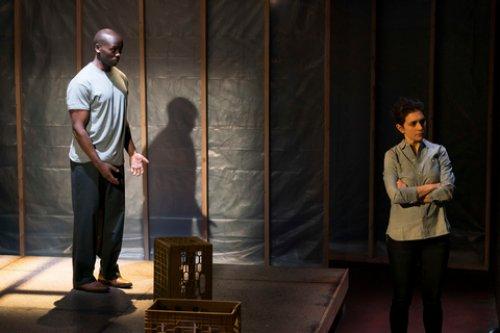Death of a Driver
This unquestionably thoughtful drama, about the ethics involved in providing aid to underdeveloped cultures, sputters when it most needs to blaze.

Patrick J. Ssenjovu and Sarah Baskin in a scene from Will Snider’s “Death of a Driver” (Photo credit: Ben Hider)
[avatar user=”Mark Dundas Wood” size=”96″ align=”left” ] Mark Dundas Wood, Critic[/avatar]In an insert to the Playbill for Urban Stages’ two-hander, Death of a Driver, playwright Will Snider notes that the play explores delicate questions related to foreign aid for underdeveloped cultures. “[H]ow do we go about transnational work ethically?” he asks. “Is there a way?” Snider explains that he himself faced such issues while working for an agricultural nonprofit in Kenya.
His play, directed by Kim T. Sharp, also takes place in Kenya—specifically, outside the city of Kisumu, beginning in 2002 and continuing for more than a decade. When we meet the protagonist, Sarah (Sarah Baskin), she is an American grad student in engineering who has a plan for rebuilding roads in the country. In the first scene she becomes acquainted with Kennedy (Patrick J. Ssenjovu), a local taxi driver. In short order, he convinces her that she will need an African driver during her time in Kenya.
In a series of relatively short scenes, we then see the lives of the two characters unfold as the engineering project progresses. Along the way, Sarah meets a Briton, who becomes her boyfriend for a time. Kennedy marries and fathers a daughter, naming her Sarah, after his boss. More significantly, he becomes not just Sarah’s driver but also her fixer and—it seems—her virtual business partner.

Patrick J. Ssenjovu and Sarah Baskin in a scene from Will Snider’s “Death of a Driver” (Photo credit: Ben Hider)
But complications arise along the way. There are political dimensions to Kennedy’s character that Sarah glimpses but never quite fully comprehends, and they begin to affect his work with her. He winds up in jail periodically because of his questionable activism. What seemed to have been an unbreakable alliance between the two characters seems increasingly to be a fragile one. Communication erodes. Suspicions become stronger, on both sides, that Sarah and Kennedy’s credo—“We are together”—may be an illusion or even a lie.
The play is carefully plotted, and the tragic action that Snider builds runs its course in a logical, plausible fashion. But something about Death of a Driver never quite catches fire. The story has gravity but lacks the sense of pity and terror that tragedy is famously supposed to invoke. Maybe it’s partly due to the fact that the play is so brief, and that its short scenes sometimes take place years apart, creating a kind of herky-jerky quality. Maybe it’s because the world of the play is relatively narrow—with the lack of supporting characters preventing us from getting a full sense of the Kenyan culture and political landscape.
SSenjovu gives a believable and nicely modulated performance, with the emotional underpinnings of Kennedy’s character fully evident throughout. But Baskin’s performance lacks comparable depth. In one scene, Sarah tells Kennedy about late-night anonymous phone calls she’s received, threatening her life. The sheer terror that such a thing would provoke comes off as muted. But why? Yes, it’s clear that Sarah is a strong woman—someone who strives to be seen as courageous and self-sufficient, someone who has become used to the rough-and-tumble business practices of the country, and who regularly pays the bribes required to get along in the culture. Even so, wouldn’t she be more visibly shaken by such threats? We get little sense of that from Baskin. It’s a curiously underheated performance.

Patrick J. Ssenjovu and Sarah Baskin in a scene from Will Snider’s “Death of a Driver” (Photo credit: Ben Hider)
In the script, the playwright outlines his vision for the abstract scenic design: a unit set that represents both a bar where the characters hang out and the various prisons where Kennedy is incarcerated. A raised platform signifies the bar area, and the troughs surrounding it serve as the jail spaces. Frank J. Oliva’s scenic design follows Snider’s guidelines. His set has the look of a construction site, with an unfinished wall upstage. Crates are used as furniture. In his script, Snider writes that the bar scenes take place is an outdoor area where drinks are served, rather than in a conventional indoor barroom. But whether this is clear to the audiences is doubtful. One may wonder why, if they are in a bar setting, the characters are so often on their feet, moving about.
John Salutz’s lighting design helps somewhat in establishing the locales, and there are some effective moments created by a cluster of light-bulb cages hanging from a chicken-wire roof over the stage. The sound design by Ian Wehrle includes music establishing setting and mood. Gail Cooper-Hecht provides a single set of costumes for each character, with some minor modifications in how they’re worn from scene to scene. Similarly, Baskin keeps her hair pulled back in some scenes and lets it fall free in others.
Snider’s aims in the play are admirable. He clearly has plenty to say about the slippery underbelly of “benevolent” deeds. But whether he’s found the best vehicle for making his points is debatable.
Death of a Driver (through March 24, 2019)
Urban Stages, 259 West 30th Street, in Manhattan
For tickets, call 866-811-4111 or visit http://www.urbanstages.org
Running time: 75 minutes without an intermission






Leave a comment